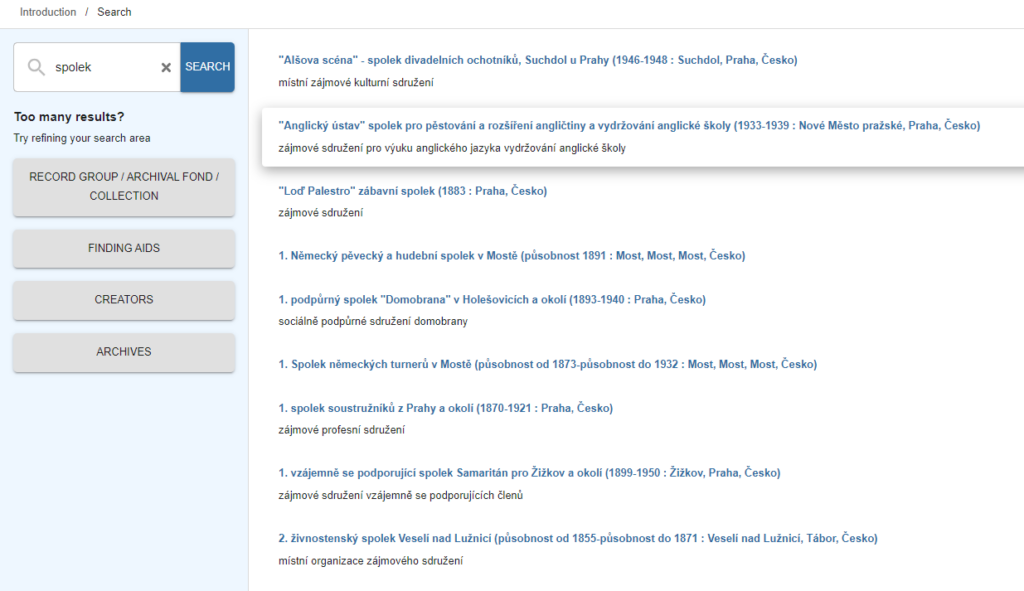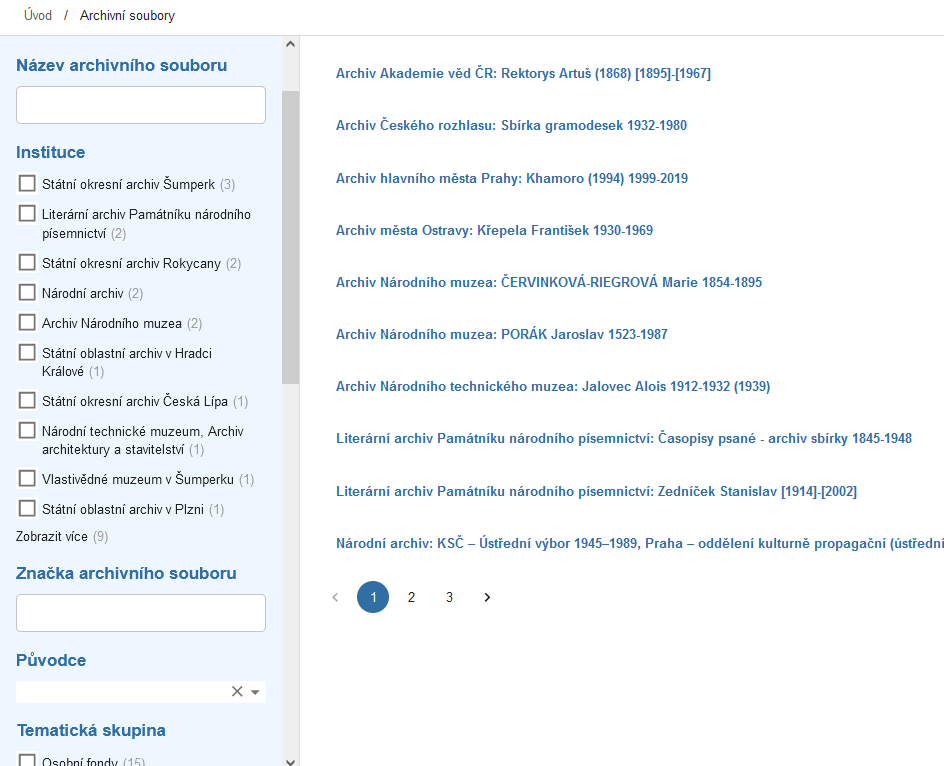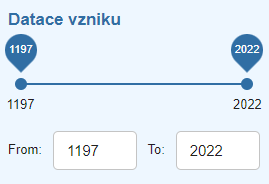What to look for and how?
On the landing page, you will find an overview of all archives and cultural and scientific institutions (museums, libraries, galleries, institutes of the Academy of Sciences of the Czech Republic, universities) that keep archival records, links to the archives’ websites and links to their major digitisation projects.
From the landing page, it is also possible to search the central register of the National Archival Heritage of the Czech Republic, which contains data on archival fonds and archival collections, archival aids connected to the files, the archives in which the files are deposited, and the originators who created the archival fonds. The content of the archival aids (description of individual archival records and groups thereof) is expected to be gradually supplemented in the future. It contains data from all archives of the Czech Republic, cultural and scientific institutions, and private persons (archival records deposited outside archives), with the exception of security archives.
Searching in the central register of the National Archival Heritage
Enter a word, group of words or abbreviation in the search box. You will get records of archival fonds and archival collections, archival aids, originators, and archives. Then limit the search results by selecting which part of the register you want to search. If you are not yet proficient in searching or do not know the Czech language well (nor do you have a translator at your disposal), we recommend that you search further only in the “Archival fonds and archival collections” section.

Searching archival fonds and archival collections
You can search by the name of the archival fond and archival collection, the archive that takes care of the archival records, the National Archival Heritage number, the originator who created the archival records, the thematic groups and the date of creation of the archival records.

Searching finding aids
You can search by the name of the archival finding aid, archive, and archival fond and archival collection name.
Searching the list of creators
You can search by the name of the creator. You can further limit the search by entity type (corporation, family, person, event) or by entity subclass.
Searching the archives
Search by the word in the name of the archives or cultural and scientific institution.
Pages with search results
Click on the name of the archival fond or archival collection to access the following information about the file:
- Name of the archival fond/collection – Czech names; in the case of archival fonds, the names are usually based on the official or otherwise commonly used name of their creator
- Date of origin –indicates the timeframe from which the archival records of the mentioned archival fond originate. The year in square brackets is an estimate. Years that are related to the archival fond or archival collection but fall beyond the period of existence of the originator of the archival fond are given in round brackets. The results can be limited by directly specifying a creation date or by using a timeline:

- Archival fond/collection mark – an abbreviated designation of an archival fond or archival collection usually used for citation and communication with the archive. It is used on the packaging where archival records are deposited (usually archival boxes).
- Institution – the name of the archive or cultural and scientific institution where the archival fond or archival collection is deposited or which keeps the archival records in its registry.
- National Archival Heritage number – within the institution, a unique registration number of the archival fond/collection or part thereof (e.g. 1251/5).
- Theme – information about the contents of the archival fond or archival collection, highlighting its most important parts, documents, or most valuable archival records and basic types of archival records, e.g. type of official books. Where sheet music is reported as written documents, there is an indication of the presence of sheet music. This field does not need to be filled in for archival fonds and archival collections that have not been processed by an archive.
- Thematic group – superior, more general term to which an archival fond or archival collection can be assigned and under which other archival fond or archival collections of the same type are classified according to common features (e.g., manors, family archives, enterprises, etc.). Archival fonds and archival collections may be classified under one or more of such groups.
- Literature – list of the essential literature concerning the archival fond or archival collection (e.g. guide to archives) or its originator, etc.
- Editions – indicates the editions of the archival records from the respective archival fond or archival collection.
- Extent – the number of “running metres” of archival records of a given archival fond or archival collection. This figure indicates the size of the file and also which part is processed (has a temporary archival aid) or inventoried (has an archival aid such as an inventory or catalogue). In archives, archival records are measured in metres (to illustrate: one running metre is about 8 archival cartons or 10 binders). The total size of the archival fond or archival collection is the sum of the unprocessed and processed extent of archival records. In the case of digital archives, the size in bytes is indicated for the relevant recording unit.
- Registration units – archives report archival records within the archival fond or archival collection using registration units, the overview and explanation of which is contained in Annex 1 of the Decree 645/2004 Coll (available in Czech only). The number of units of the relevant registration unit is indicated.
- Parts of the archival fond or archival collection in other institutions – if archival records of the same creator are also deposited in another archive or cultural and scientific institution, information about these archival records or the relevant archive is given.
- Language – a list of languages used in the archival records of the archival fond or archival collection.
- About the creator – a text overview of the originators of the archival records (natural person, family, corporation, temporary corporation, i.e. event), whose activities led to the creation of the archival fonds; for archival collections, who created the collection is indicated. The period during which the originator existed or was active is also indicated.
- Creator – information regarding the originators (agencies), the description of which is harmonised within the central register, and which can be used to search in other than textual form.
- Places of origin – the places of origin of the archival fond or archival collection are indicated, usually the creator’s residence or registered office. This information does not need to be provided for personal fonds and collections created directly by the institution keeping the archival records.
- State of preservation – the data indicates the extent to which the archival records have been preserved (completely, with gaps, fragmented) and also their physical integrity, possibly with the indication of the nature of the damage (e.g. damaged by rodents, fragile, damaged by flood).
- Registration status – in some cases, archival records may be deposited in an institution under a deposit agreement or deposited outside the archive (e.g. in private possession). In such cases, access to the records may be denied or granted subject to special conditions.
- Accessibility – depends on the existence of an archival aid and therefore accessibility for researchers (accessible, partially accessible, inaccessible). It is only indicative. The actual accessibility (state of processing) should be consulted with the relevant archive or cultural and scientific institution.
- Archival finding aid – indication of an archival aid, i.e. a description of the archival fond or archival collection in varying detail. Click on the name of the archival aid to get more detailed information. If the finding aid is listed as electronic, it may be advisable to visit the website of the relevant archive (see homepage).
More detailed information about the relevant archival fonds and archival collections can only be provided by the institution that has the file in its care and keeps it in its registers of the National Archival Heritage.
